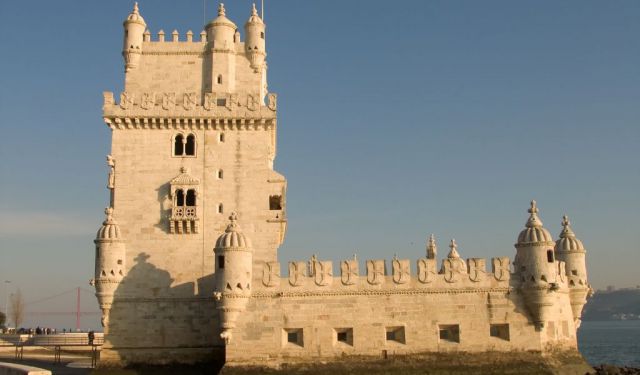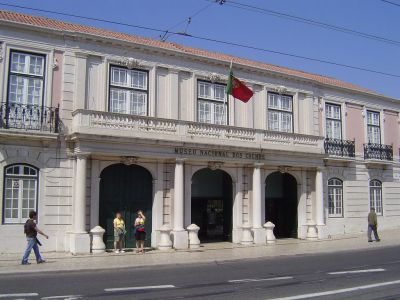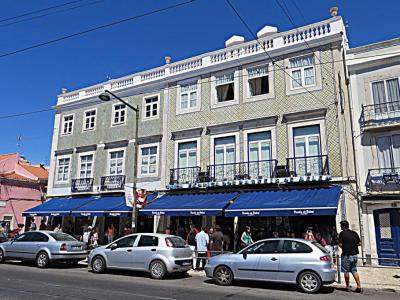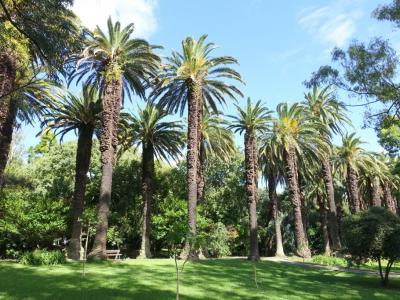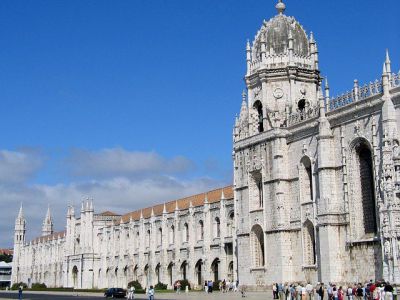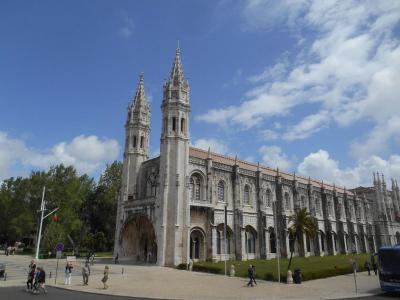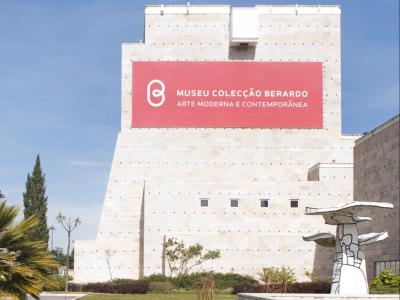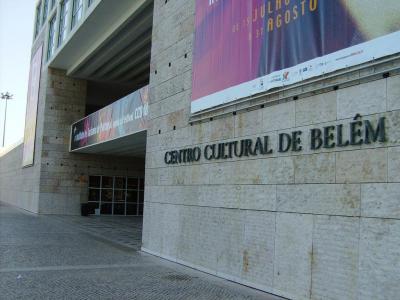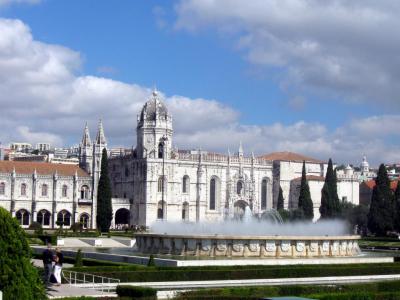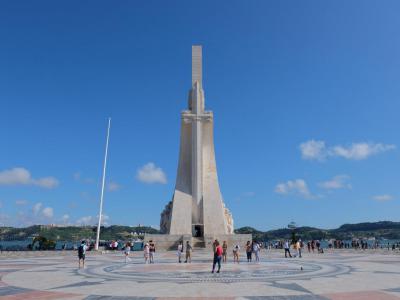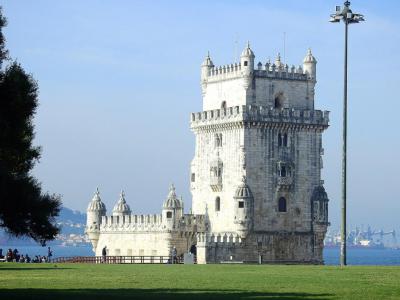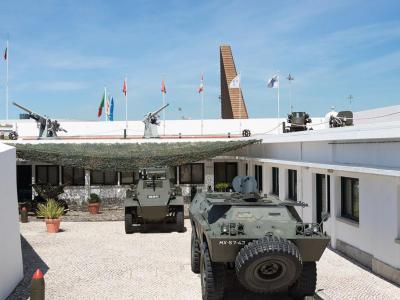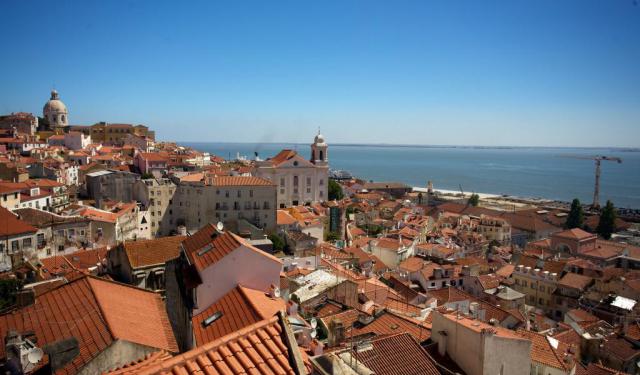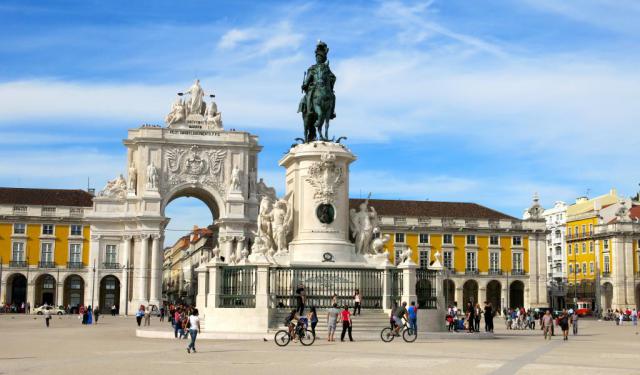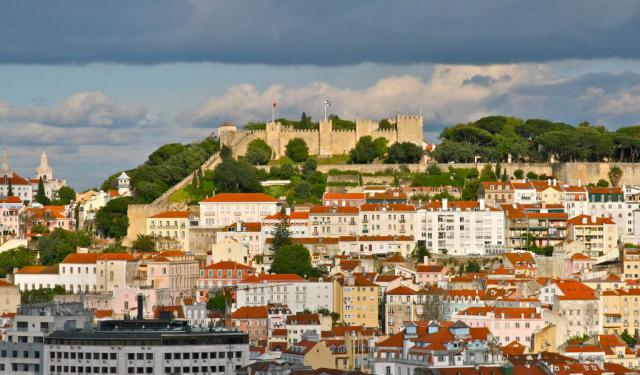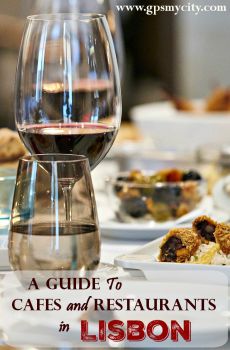Belem Walking Tour (Self Guided), Lisbon
Also known as Santa Maria de Belem, the district of Belem is one of the most visited in Lisbon. Situated not far from the city center, it lines the Tagus River and is the original location of Lisbon's port – the starting point of the many great voyages of discovery by Portuguese explorers, such as Vasco da Gama – departed from here for India in 1497, and Pedro Alvares Cabral – for Brazil in 1499.
Perhaps Belem's most famous feature is its tower, Belem Tower. Built as a fortified lighthouse on the small rocky outcropping along the northern margin of the Tagus River, late in the reign of Dom Manuel l (1515–1520), it used to guard entrance to the port, as well as partly defended another major historical site, the Hieronymites Monastery built by Henry the Navigator to support pilgrims coming to the region. Located along Empire Square, presently, the monastery is a UNESCO-listed location and a home to the Navy Museum, among other things.
Belem is a concentration of national monuments and a mixture of historical buildings and modern symbols of Portuguese culture. The district's most notable modern feature is the Monument to the Discoveries inaugurated in 1960 to mark the 500th anniversary of the death of Henry the Navigator. Another key local monument is that to the Combatants of the Portuguese Colonial Wars.
Belem is also famous as a museum district, accommodating a host of world-class museums, among which there are the National Coach Museum and the Berardo Collection Museum.
Amid the juxtaposition of famous locations is the famous pastry shop Fabrica de Pasteis de Belem, known for a specific Portuguese egg tart pastry: pastel de Belem.
For a closer acquaintance with the architectural marvels and cultural delights of this beautiful part of the Portuguese capital, take our self-guided walking tour and enjoy Belem at its best!
Perhaps Belem's most famous feature is its tower, Belem Tower. Built as a fortified lighthouse on the small rocky outcropping along the northern margin of the Tagus River, late in the reign of Dom Manuel l (1515–1520), it used to guard entrance to the port, as well as partly defended another major historical site, the Hieronymites Monastery built by Henry the Navigator to support pilgrims coming to the region. Located along Empire Square, presently, the monastery is a UNESCO-listed location and a home to the Navy Museum, among other things.
Belem is a concentration of national monuments and a mixture of historical buildings and modern symbols of Portuguese culture. The district's most notable modern feature is the Monument to the Discoveries inaugurated in 1960 to mark the 500th anniversary of the death of Henry the Navigator. Another key local monument is that to the Combatants of the Portuguese Colonial Wars.
Belem is also famous as a museum district, accommodating a host of world-class museums, among which there are the National Coach Museum and the Berardo Collection Museum.
Amid the juxtaposition of famous locations is the famous pastry shop Fabrica de Pasteis de Belem, known for a specific Portuguese egg tart pastry: pastel de Belem.
For a closer acquaintance with the architectural marvels and cultural delights of this beautiful part of the Portuguese capital, take our self-guided walking tour and enjoy Belem at its best!
How it works: Download the app "GPSmyCity: Walks in 1K+ Cities" from Apple App Store or Google Play Store to your mobile phone or tablet. The app turns your mobile device into a personal tour guide and its built-in GPS navigation functions guide you from one tour stop to next. The app works offline, so no data plan is needed when traveling abroad.
Belem Walking Tour Map
Guide Name: Belem Walking Tour
Guide Location: Portugal » Lisbon (See other walking tours in Lisbon)
Guide Type: Self-guided Walking Tour (Sightseeing)
# of Attractions: 11
Tour Duration: 2 Hour(s)
Travel Distance: 3.0 Km or 1.9 Miles
Author: DanaOffice
Sight(s) Featured in This Guide:
Guide Location: Portugal » Lisbon (See other walking tours in Lisbon)
Guide Type: Self-guided Walking Tour (Sightseeing)
# of Attractions: 11
Tour Duration: 2 Hour(s)
Travel Distance: 3.0 Km or 1.9 Miles
Author: DanaOffice
Sight(s) Featured in This Guide:
- Museu Nacional dos Coches (National Coach Museum)
- Pasteis de Belem (Belem Pastries)
- Jardim Botanico Tropical (Tropical Botanical Garden)
- Mosteiro dos Jerónimos (Hieronymites Monastery)
- Museu de Marinha (Navy Museum)
- Museu Colecao Berardo (Berardo Collection Museum)
- Centro Cultural de Belem (Belem Cultural Center)
- Praca do Imperio (Empire Square)
- Padrao dos Descobrimentos (Monument to the Discoveries)
- Torre de Belem (Belem Tower)
- Forte do Bom Sucesso & Museu de Combatente (Fort of Good Success & Combatant's Museum)
1) Museu Nacional dos Coches (National Coach Museum)
The National Coach Museum, established in 1905 by Queen Amélia, was created to house a vast collection of carriages that once belonged to the Portuguese royal family and nobility. This collection, undoubtedly the most impressive and extensive of its kind globally, provides a comprehensive overview of carriage development from the late 16th to the 19th centuries, with carriages crafted in Italy, Portugal, Spain, France, Austria, and England.
Among the most extraordinary pieces is a late 16th/early 17th-century traveling coach once used by King Philip II of Portugal for his journey from Spain to Portugal in 1619. The museum also showcases several extravagant Baroque carriages from the 18th century adorned with paintings and ornate gilt woodwork. The most notable of these is a ceremonial coach gifted by Pope Clement XI to King John V in 1715, as well as the three carriages of the Portuguese ambassador to Pope Clement XI, constructed in Rome in 1716.
The museum's original location, the Royal Riding Hall of Belém, houses a select number of carriages along with early emergency response vehicles. In contrast, the new, modern location nearby features approximately 70 or more carriages of various sizes and functions. Detailed explanations are provided in Portuguese, English, French, and Spanish for each carriage, and interactive displays allow you to explore their interiors from different angles.
Why You Should Visit:
This museum stands out as the premier institution of its kind worldwide. The preservation, restoration, and effective display of so many carriages are nothing short of remarkable.
Tip:
Don't miss the older second building, located just a block away from the new facility. The interior is well worth the visit.
Among the most extraordinary pieces is a late 16th/early 17th-century traveling coach once used by King Philip II of Portugal for his journey from Spain to Portugal in 1619. The museum also showcases several extravagant Baroque carriages from the 18th century adorned with paintings and ornate gilt woodwork. The most notable of these is a ceremonial coach gifted by Pope Clement XI to King John V in 1715, as well as the three carriages of the Portuguese ambassador to Pope Clement XI, constructed in Rome in 1716.
The museum's original location, the Royal Riding Hall of Belém, houses a select number of carriages along with early emergency response vehicles. In contrast, the new, modern location nearby features approximately 70 or more carriages of various sizes and functions. Detailed explanations are provided in Portuguese, English, French, and Spanish for each carriage, and interactive displays allow you to explore their interiors from different angles.
Why You Should Visit:
This museum stands out as the premier institution of its kind worldwide. The preservation, restoration, and effective display of so many carriages are nothing short of remarkable.
Tip:
Don't miss the older second building, located just a block away from the new facility. The interior is well worth the visit.
2) Pasteis de Belem (Belem Pastries)
During Portuguese medieval history, the country's monasteries and convents were renowned for their ability to produce significant quantities of eggs, with a particular demand for their egg whites, which were highly sought after for various purposes, including starching clothes (such as the habits worn by nuns) and for wine production, especially in the clarification of wines like Porto. Interestingly, these religious institutions often found themselves with an abundance of egg yolks, which led to the development of numerous sweet pastry recipes throughout Portugal, including the iconic 'pastéis de nata' – small pies filled with cream that are believed to have originated before the 18th century, attributed to Catholic monks at the Jerónimos Monastery.
However the expulsion of religious orders and the subsequent closure of many religious establishments following the 1820 Liberal Revolution brought about a change in the production of 'pastéis de nata'. This culinary tradition was relocated to the nearby Casa Pastéis de Belém, giving rise to the popular name "Pastéis de Belém" due to its association with the parish of Santa Maria de Belém. To safeguard the unique and secret recipe, former religious clerics took the step of patenting and officially registering the confection. They also entered into a partnership with Antiga Confeiteira de Belém, Lda. to continue crafting these pastries. The secret recipe was entrusted to five master pastry chefs, who preserved the original formula under the Oficina do Segredo, later passing it on to their descendants.
Since 1837, both locals and tourists exploring Lisbon have been drawn to this bakery to savor fresh-from-the-oven 'pastéis', sprinkled with cinnamon and powdered sugar. Their popularity and affordability normally result in long lines, so rather than waiting for a table, you might as well take the standing option at the bar or order to go (separate line; 4/6/10/12 pieces). With its original furniture and charming old-world ambiance, the location is outstanding, so consider arriving early to fully relish this experience in a tranquil setting.
However the expulsion of religious orders and the subsequent closure of many religious establishments following the 1820 Liberal Revolution brought about a change in the production of 'pastéis de nata'. This culinary tradition was relocated to the nearby Casa Pastéis de Belém, giving rise to the popular name "Pastéis de Belém" due to its association with the parish of Santa Maria de Belém. To safeguard the unique and secret recipe, former religious clerics took the step of patenting and officially registering the confection. They also entered into a partnership with Antiga Confeiteira de Belém, Lda. to continue crafting these pastries. The secret recipe was entrusted to five master pastry chefs, who preserved the original formula under the Oficina do Segredo, later passing it on to their descendants.
Since 1837, both locals and tourists exploring Lisbon have been drawn to this bakery to savor fresh-from-the-oven 'pastéis', sprinkled with cinnamon and powdered sugar. Their popularity and affordability normally result in long lines, so rather than waiting for a table, you might as well take the standing option at the bar or order to go (separate line; 4/6/10/12 pieces). With its original furniture and charming old-world ambiance, the location is outstanding, so consider arriving early to fully relish this experience in a tranquil setting.
3) Jardim Botanico Tropical (Tropical Botanical Garden)
Also referred to as the Jardim do Ultramar, this serene park, adorned with tranquil ponds, graceful waterfowl, and resplendent peacocks, curiously seems to attract a relatively modest number of visitors. Conceived at the inception of the 20th century with the primary purpose of serving as the research hub for the Institute for Tropical Sciences, it adopts more the character of an arboreal sanctuary than a conventional flower garden. Its central focus revolves around the cultivation of rare and imperiled tropical and subtropical trees and flora.
Among the most striking specimens are the enigmatic dragon trees, indigenous to the Canary Islands and Madeira, monkey puzzle trees hailing from South America, and a majestic boulevard of Washington palms. Announcing itself through an impressive gateway that evokes traditional Chinese architectural aesthetics, a delightful Chinese-inspired garden beckons with its meandering streams, picturesque bridges, and vibrant hibiscus blooms, which represented Macau in the Exhibition of the Portuguese World in 1940.
Neighboring this verdant haven, the research facilities find their abode within the Palácio dos Condes da Calheta, whose interior unfolds an exquisite tapestry of 'azulejos' spanning three centuries.
Why You Should Visit:
With its lush hothouses, placid ponds, and towering palm sentinels, it constitutes an ideal locale for a leisurely, shaded promenade.
Tip:
Tucked away in the southeastern corner lies the official residence of the President ("Presidência da República"), adorned in a rosy hue. On Saturdays, it opens its opulent state chambers for guided tours, with entrance facilitated through Praça Afonso de Albuquerque. Operating hours are from 10:30am to 4:30pm, and admission is €5.
Among the most striking specimens are the enigmatic dragon trees, indigenous to the Canary Islands and Madeira, monkey puzzle trees hailing from South America, and a majestic boulevard of Washington palms. Announcing itself through an impressive gateway that evokes traditional Chinese architectural aesthetics, a delightful Chinese-inspired garden beckons with its meandering streams, picturesque bridges, and vibrant hibiscus blooms, which represented Macau in the Exhibition of the Portuguese World in 1940.
Neighboring this verdant haven, the research facilities find their abode within the Palácio dos Condes da Calheta, whose interior unfolds an exquisite tapestry of 'azulejos' spanning three centuries.
Why You Should Visit:
With its lush hothouses, placid ponds, and towering palm sentinels, it constitutes an ideal locale for a leisurely, shaded promenade.
Tip:
Tucked away in the southeastern corner lies the official residence of the President ("Presidência da República"), adorned in a rosy hue. On Saturdays, it opens its opulent state chambers for guided tours, with entrance facilitated through Praça Afonso de Albuquerque. Operating hours are from 10:30am to 4:30pm, and admission is €5.
4) Mosteiro dos Jerónimos (Hieronymites Monastery) (must see)
The Hieronymites (or "Jerónimos") Monastery was built in 1601 to commemorate the historic journey of Portuguese explorer Vasco da Gama and to express gratitude to the Virgin Mary for his pioneering achievement as the first European to reach India by sea. Construction spanned precisely a century, after which it was entrusted to the San Jerónimo order, whose mission was to offer prayers for the King and provide guidance to sailors embarking on voyages to uncover new sea routes and lands. In 1983, it was designated a UNESCO World Heritage Monument, serving as an enduring symbol of Portugal's power and affluence during the Age of Discovery.
Featuring the finest examples of what came to be known as Manueline style, the monastery encompasses various elements that were pivotal during the Golden Age of the rapidly expanding Portuguese Empire. These include intricate nautical motifs, such as ropes and compasses, carved into the pastel-colored limestone. Notable architectural features encompass the remarkable double-layered cloister, ornate arches that encircle the cloister's open passageway, the Church of Santa Maria, adorned with a fitting statue of Saint Mary atop its imposing southern portal, the monastery's refectory, the Lion Fountain located outside, and the final resting place of Portugal's eminent poets, explorers, monarchs, and statesmen. From Vasco da Gama to Luís de Camões, and from King Manuel I to the leading modernist, Fernando Pessoa, all these elements and more make it well worth dedicating a separate visit of at least 2 to 3 hours.
Why You Should Visit:
Unexpected beauty for a monastery! One could easily spend hours admiring the intricate stone decorations. Even during peak visitor times, it maintains a sense of spaciousness, and there's an excellent exhibit providing explanations in both Portuguese and English.
Tip:
When facing the main entrance, the ticket queue is located on the LEFT. Alternatively, consider purchasing a 'joint' ticket at the nearby Archaeological Museum, which costs €2 more but provides access to both the monastery and the museum. This can save you time by bypassing the often lengthy queue for the 'monastery-only' ticket.
Featuring the finest examples of what came to be known as Manueline style, the monastery encompasses various elements that were pivotal during the Golden Age of the rapidly expanding Portuguese Empire. These include intricate nautical motifs, such as ropes and compasses, carved into the pastel-colored limestone. Notable architectural features encompass the remarkable double-layered cloister, ornate arches that encircle the cloister's open passageway, the Church of Santa Maria, adorned with a fitting statue of Saint Mary atop its imposing southern portal, the monastery's refectory, the Lion Fountain located outside, and the final resting place of Portugal's eminent poets, explorers, monarchs, and statesmen. From Vasco da Gama to Luís de Camões, and from King Manuel I to the leading modernist, Fernando Pessoa, all these elements and more make it well worth dedicating a separate visit of at least 2 to 3 hours.
Why You Should Visit:
Unexpected beauty for a monastery! One could easily spend hours admiring the intricate stone decorations. Even during peak visitor times, it maintains a sense of spaciousness, and there's an excellent exhibit providing explanations in both Portuguese and English.
Tip:
When facing the main entrance, the ticket queue is located on the LEFT. Alternatively, consider purchasing a 'joint' ticket at the nearby Archaeological Museum, which costs €2 more but provides access to both the monastery and the museum. This can save you time by bypassing the often lengthy queue for the 'monastery-only' ticket.
5) Museu de Marinha (Navy Museum)
Given Portugal's renowned status as the world's foremost seafaring nation, it's only natural that the Navy Museum would spotlight the history of its New World explorers who not only discovered crucial trade routes but also played pivotal roles in early forms of globalization through worldwide trade. The museum's initial section does just that and more, offering a fresh perspective on Portugal's maritime empire with astonishing paintings, detailed accounts of the navy's history, in addition to eye-catching miniature models of the evolving boats and ships – but make sure to conserve energy for the rest of your visit!
Make sure not to overlook the last pavilion, where you'll find exquisite full-sized barges and sailboats that were once the preferred means of transportation for royalty on both leisure and business excursions. Additionally, you can admire a selection of truly historic aircraft, including the seaplane that achieved the remarkable feat of crossing the Atlantic in 1922. As you conclude your tour, you'll be directed to a quality souvenir shop, conveniently linked to a café that offers light meals. It's important to ensure you've explored everything before entering the café or shop since re-entry is not possible.
Usually not too busy and with affordable regular prices, the museum offers free entry on the first Sunday of the month.
Why You Should Visit:
Wonderfully laid out and spacious, with interesting and informative displays as well as useful English descriptions for the majority of its displays. Highly recommended for those fond of ships, geography, discoveries, exploration, and the pursuit of knowledge.
Tip:
The surroundings comprise a range of historically and culturally significant establishments, including the Vasco da Gama Aquarium, the Frigate Fernando II & Gloria, and the Calouste Gulbenkian Planetarium, each of which can be explored independently.
Make sure not to overlook the last pavilion, where you'll find exquisite full-sized barges and sailboats that were once the preferred means of transportation for royalty on both leisure and business excursions. Additionally, you can admire a selection of truly historic aircraft, including the seaplane that achieved the remarkable feat of crossing the Atlantic in 1922. As you conclude your tour, you'll be directed to a quality souvenir shop, conveniently linked to a café that offers light meals. It's important to ensure you've explored everything before entering the café or shop since re-entry is not possible.
Usually not too busy and with affordable regular prices, the museum offers free entry on the first Sunday of the month.
Why You Should Visit:
Wonderfully laid out and spacious, with interesting and informative displays as well as useful English descriptions for the majority of its displays. Highly recommended for those fond of ships, geography, discoveries, exploration, and the pursuit of knowledge.
Tip:
The surroundings comprise a range of historically and culturally significant establishments, including the Vasco da Gama Aquarium, the Frigate Fernando II & Gloria, and the Calouste Gulbenkian Planetarium, each of which can be explored independently.
6) Museu Colecao Berardo (Berardo Collection Museum) (must see)
In addition to Belém's historic landmarks, an equally remarkable attraction awaits: an extraordinary collection of modern art amassed by the renowned business magnate and art connoisseur José Berardo, often hailed as Portugal's counterpart to Charles Saatchi or François Pinault. With approximately 1,000 works by over 500 artists, this gallery serves as a treasure trove chronicling a century of modern and contemporary art across a diverse range of mediums, including painting, sculpture, photography, and cutting-edge video installations.
While not all pieces from the extensive collection are exhibited simultaneously, visitors are treated to the works of some of the world's most esteemed modern artists. Depending on the timing of your visit, you may encounter Andy Warhol's iconic "Judy Garland", Eric Fischl's awe-inspiring panels depicting sunbathers, or Chris Ofili's provocative "Adoration of Captain Shit", crafted using genuine dung. Noteworthy highlights also include Picasso's "Tête de femme" (1909), an excellent representation of the Spanish artist's Cubist style, Jeff Koons' whimsical "Poodle" (1991), striking sculptures by Alberto Carneiro, etchings by Paula Rego, and a captivating selection of photographs by Fernando Lemos.
Why You Should Visit:
An ideal destination to unravel the enduring enigma of modern art. The exhibits are thoughtfully curated and showcased within an equally remarkable building. On the lower floors, you'll find engaging temporary exhibitions, while the upper floors take you on a comprehensive journey through the history of contemporary European art.
Tip:
When you're ready to indulge in some refreshments, consider visiting the café located in the adjacent conference center. It offers a serene ambiance, devoid of crowds, and provides excellent value for a tea, coffee, or lunch experience.
While not all pieces from the extensive collection are exhibited simultaneously, visitors are treated to the works of some of the world's most esteemed modern artists. Depending on the timing of your visit, you may encounter Andy Warhol's iconic "Judy Garland", Eric Fischl's awe-inspiring panels depicting sunbathers, or Chris Ofili's provocative "Adoration of Captain Shit", crafted using genuine dung. Noteworthy highlights also include Picasso's "Tête de femme" (1909), an excellent representation of the Spanish artist's Cubist style, Jeff Koons' whimsical "Poodle" (1991), striking sculptures by Alberto Carneiro, etchings by Paula Rego, and a captivating selection of photographs by Fernando Lemos.
Why You Should Visit:
An ideal destination to unravel the enduring enigma of modern art. The exhibits are thoughtfully curated and showcased within an equally remarkable building. On the lower floors, you'll find engaging temporary exhibitions, while the upper floors take you on a comprehensive journey through the history of contemporary European art.
Tip:
When you're ready to indulge in some refreshments, consider visiting the café located in the adjacent conference center. It offers a serene ambiance, devoid of crowds, and provides excellent value for a tea, coffee, or lunch experience.
7) Centro Cultural de Belem (Belem Cultural Center)
Situated between the Tagus River and the Jerónimos Monastery, this contemporary and stylish building, crafted from pink marble, was constructed to serve as the headquarters for the Portuguese presidency of the European Community. It was conceived by a collaboration between Italian and Portuguese architects, Vittorio Gregotti and Manuel Salgado, and earned recognition by winning the International Stone Architecture Award at the Verona Fair in 1993. In that same year, it transformed into a cultural center that offers a diverse range of artistic experiences, encompassing performing arts, music, and photography. Inside its premises lies an exhibition center that houses the Berardo Collection Museum ("Museu Colecção Berardo").
Spanning an expansive 97,000 square meters, the CCB radiates an open, airy, and spacious ambiance, setting it apart from many other significant art galleries, which often feel confined by comparison. Its remarkable collection of modern and contemporary art, spanning from the 1960s to the present day, showcases an array of valuable artworks, including pieces by renowned artists such as Picasso and Warhol. This collection continually thrives, enriched by frequent visiting exhibitions, live outdoor performances, and indoor concerts. Nevertheless, the sheer aesthetic delight of the interior space is a marvel in itself.
The building's architectural lines are truly exceptional, and even its external features, including walkways and gardens that offer scenic views of the waterfront, deserve high praise. One of the gardens boasts undulating grassy "waves" where visitors can recline on beanbags beneath olive trees while enjoying breathtaking vistas of the river, the '25 of April' bridge (designed by the same architect as San Francisco's Golden Gate Bridge), and the Christo Rei statue. The other garden boasts a Henry Moore sculpture that seamlessly integrates into its surroundings. Additionally, the CCB provides a bar and a restaurant, or you can opt for the charming café adjacent to the gift shop to savor some delectable rolls and pastries.
Tip:
If you're interested in participating in a workshop or attending an evening concert at this venue, please review the timetable. Additionally, consider planning your visit for a Saturday to take advantage of complimentary access to the Berardo Collection Museum, acclaimed as the "Most Visited Museum in Portugal" as of April 2019.
Spanning an expansive 97,000 square meters, the CCB radiates an open, airy, and spacious ambiance, setting it apart from many other significant art galleries, which often feel confined by comparison. Its remarkable collection of modern and contemporary art, spanning from the 1960s to the present day, showcases an array of valuable artworks, including pieces by renowned artists such as Picasso and Warhol. This collection continually thrives, enriched by frequent visiting exhibitions, live outdoor performances, and indoor concerts. Nevertheless, the sheer aesthetic delight of the interior space is a marvel in itself.
The building's architectural lines are truly exceptional, and even its external features, including walkways and gardens that offer scenic views of the waterfront, deserve high praise. One of the gardens boasts undulating grassy "waves" where visitors can recline on beanbags beneath olive trees while enjoying breathtaking vistas of the river, the '25 of April' bridge (designed by the same architect as San Francisco's Golden Gate Bridge), and the Christo Rei statue. The other garden boasts a Henry Moore sculpture that seamlessly integrates into its surroundings. Additionally, the CCB provides a bar and a restaurant, or you can opt for the charming café adjacent to the gift shop to savor some delectable rolls and pastries.
Tip:
If you're interested in participating in a workshop or attending an evening concert at this venue, please review the timetable. Additionally, consider planning your visit for a Saturday to take advantage of complimentary access to the Berardo Collection Museum, acclaimed as the "Most Visited Museum in Portugal" as of April 2019.
8) Praca do Imperio (Empire Square)
Comprised of formal walkways and gardens, Empire Square occupies the space that was once Belém's beachfront. It enjoys significant popularity, particularly on Saturday mornings, when the Monastery of Santa Maria de Belém often hosts weddings, with photo sessions extending into the square. Otherwise, a good spot to relax by the fountain and let the breeze provide a refreshing shower.
The rectangular square spans 175x175 meters (574x574 ft) and is divided into interconnected quadrangles, creating passages and green areas. These converging pathways lead to a centrally placed illuminated fountain on a square platform, covering an expanse of 3,300 square meters (36,000 square feet). Along the southern perimeter of the square, near Avenida da Índia, you'll find hippocamp statues (seahorses) overlooking reflective pools.
Situated on the eastern edge of the park, the Overseas Palace ("Palácio do Ultramar") dates back to the 1950s. In 1973, the municipal council of Lisbon added a commemorative monument to the poet Augusto Gil (1873-1929), featuring a bronze medallion and inscription.
Beyond the central fountain, you'll discover coats of arms associated with or attributed to explorers from the Age of Discovery. The gardens showcase 30 floral coats of arms representing 18 Portuguese districts, archipelagos, and former colonies, each adorned with the crosses of Christ and Avis. Additionally, a national emblem crafted from boxwood and flowers can be found.
Tip:
The 17th-century buildings lining Rua Vieira Portuense have been converted into restaurants, most of which offer outdoor seating. Generally, as you head further east along this street, you'll find better dining value.
The rectangular square spans 175x175 meters (574x574 ft) and is divided into interconnected quadrangles, creating passages and green areas. These converging pathways lead to a centrally placed illuminated fountain on a square platform, covering an expanse of 3,300 square meters (36,000 square feet). Along the southern perimeter of the square, near Avenida da Índia, you'll find hippocamp statues (seahorses) overlooking reflective pools.
Situated on the eastern edge of the park, the Overseas Palace ("Palácio do Ultramar") dates back to the 1950s. In 1973, the municipal council of Lisbon added a commemorative monument to the poet Augusto Gil (1873-1929), featuring a bronze medallion and inscription.
Beyond the central fountain, you'll discover coats of arms associated with or attributed to explorers from the Age of Discovery. The gardens showcase 30 floral coats of arms representing 18 Portuguese districts, archipelagos, and former colonies, each adorned with the crosses of Christ and Avis. Additionally, a national emblem crafted from boxwood and flowers can be found.
Tip:
The 17th-century buildings lining Rua Vieira Portuense have been converted into restaurants, most of which offer outdoor seating. Generally, as you head further east along this street, you'll find better dining value.
9) Padrao dos Descobrimentos (Monument to the Discoveries)
Conceived as a temporary beacon for the 1940 Portuguese World Fair, the grand Monument to the Discoveries stands as one of Lisbon's prominent symbols, embodying a romanticized vision of the nation's history. It celebrates the courageous individuals who participated in the Age of Discovery, a period of exploration during the 15th and 16th centuries that helped dispel humanity's fear of the unknown.
Situated at the mouth of the Tagus River in Belém, from where countless ships once set sail on journeys to uncharted territories, the monument takes the form of a 52-meter-high concrete structure shaped like the prow of a ship. On its inland-facing side, a towering sword is intricately carved, extending the full height of the monument. At the forefront of a lineup of statues that includes King Alfonso V, Luís de Camões, Vasco de Gama, and other Portuguese heroes, a prominent statue of Henry the Navigator stands proudly.
Inside the monument, there is a small exhibition space that often showcases exhibits related to Lisbon's history. The admission fee also grants access to an elevator ride offering brilliant panoramic views. A good zoom on your camera is essential to capture the splendid cityscape, featuring the Tagus River, the '25th of April' Bridge, the Christ the King statue, Belém Tower, and the Jerónimos Monastery.
Tip:
Don't overlook the "Rosa-dos-Ventos" at the monument's base, consisting of a wind rose and an elaborately crafted mosaic map illustrating Portugal's world discoveries, with key overseas possessions marked, each bearing the date of its discovery. Although it was added 20 years after the monument's inauguration, it seamlessly integrates with the monument both thematically and aesthetically, making Portugal the center of the world, as one would expect.
Situated at the mouth of the Tagus River in Belém, from where countless ships once set sail on journeys to uncharted territories, the monument takes the form of a 52-meter-high concrete structure shaped like the prow of a ship. On its inland-facing side, a towering sword is intricately carved, extending the full height of the monument. At the forefront of a lineup of statues that includes King Alfonso V, Luís de Camões, Vasco de Gama, and other Portuguese heroes, a prominent statue of Henry the Navigator stands proudly.
Inside the monument, there is a small exhibition space that often showcases exhibits related to Lisbon's history. The admission fee also grants access to an elevator ride offering brilliant panoramic views. A good zoom on your camera is essential to capture the splendid cityscape, featuring the Tagus River, the '25th of April' Bridge, the Christ the King statue, Belém Tower, and the Jerónimos Monastery.
Tip:
Don't overlook the "Rosa-dos-Ventos" at the monument's base, consisting of a wind rose and an elaborately crafted mosaic map illustrating Portugal's world discoveries, with key overseas possessions marked, each bearing the date of its discovery. Although it was added 20 years after the monument's inauguration, it seamlessly integrates with the monument both thematically and aesthetically, making Portugal the center of the world, as one would expect.
10) Torre de Belem (Belem Tower) (must see)
Accessed via a narrow pathway extending into the river, the Tower of Belém stands as an impressive symbol of Lisbon and holds the distinction of being a designated World Heritage Site. It represents one of Portugal's purest examples of Manueline architecture, a style prevalent during the reign of King Manuel I. Its windows and staircases are adorned with arches and decorative motifs that commemorate Portugal's explorations in the New World.
Originally constructed as a fortress on what was once an island in the middle of the Tagus River, its purpose was to safeguard the entrance to the port. The construction spanned five years and was completed in 1520. Today, the striking chalk-white tower stands near the river's northern bank, a testament to the shifting of the river's course following the earthquake of 1755.
Present-day visitors have the freedom to explore the tower's different levels, which include a terrace facing the river, once a vantage point for artillery firing. Ascending a steep spiral staircase spanning four levels, each offering a unique framed view of the river, brings you to a top terrace that provides a breezy panorama of Belém. You can also venture into the dungeons, a low-ceilinged chamber originally used for storing gunpowder, and later notorious for housing political prisoners during the 19th century under rule Dom Miguel's rule.
Tip:
The biggest draw here is ascending to the summit via the spiral staircase. Unless you're fortunate enough to find a short queue upon arrival, it's advisable to appreciate the tower's exterior garden rather than spending an extended period waiting to enter. However, if you are determined to explore the interior, it's recommended to purchase your ticket in advance online or from a kiosk located in the nearby park. Using a Lisbon Card may still require you to stand in line like everyone else, but at least you won't need to pay the admission fee!
Originally constructed as a fortress on what was once an island in the middle of the Tagus River, its purpose was to safeguard the entrance to the port. The construction spanned five years and was completed in 1520. Today, the striking chalk-white tower stands near the river's northern bank, a testament to the shifting of the river's course following the earthquake of 1755.
Present-day visitors have the freedom to explore the tower's different levels, which include a terrace facing the river, once a vantage point for artillery firing. Ascending a steep spiral staircase spanning four levels, each offering a unique framed view of the river, brings you to a top terrace that provides a breezy panorama of Belém. You can also venture into the dungeons, a low-ceilinged chamber originally used for storing gunpowder, and later notorious for housing political prisoners during the 19th century under rule Dom Miguel's rule.
Tip:
The biggest draw here is ascending to the summit via the spiral staircase. Unless you're fortunate enough to find a short queue upon arrival, it's advisable to appreciate the tower's exterior garden rather than spending an extended period waiting to enter. However, if you are determined to explore the interior, it's recommended to purchase your ticket in advance online or from a kiosk located in the nearby park. Using a Lisbon Card may still require you to stand in line like everyone else, but at least you won't need to pay the admission fee!
11) Forte do Bom Sucesso & Museu de Combatente (Fort of Good Success & Combatant's Museum)
Once utilized to safeguard Lisbon against potential threats, the Fort of Good Success now serves as a museum that encapsulates a significant portion of Portugal's military history. Adjacent to it stands a visually striking monument honoring Portuguese soldiers who fought overseas-an area designed for solemn reflection on the toll of military conflicts.
The construction of the Fort dates back to 1780-82, under the supervision of General Guilherme de Vallerée, and it was equipped with various types of artillery to fortify its defensive capabilities. Shortly thereafter, a residence for the Fort's governor was incorporated within its perimeter. The Fort's polygonal layout mirrors the contours of the right bank of the River Tagus.
During the Portuguese Colonial War (1961-75), the Fort served as the headquarters of the Military Postal Service. Following the Carnation Revolution on April 25, 1974, which brought an end to the authoritarian Estado Novo regime, it became the base for the Command of the Military Intervention Group-a body established by the Revolutionary Council to maintain law and order. Subsequently, it served as the headquarters for the 25th of April Association, an organization uniting the military members who initiated the Carnation Revolution.
In 1999, the Fort was formally transferred to the Portuguese League of Combatants. The museum, overseen by the League, features a permanent indoor exhibition and three outdoor areas displaying equipment associated with various branches of the Armed Forces. The permanent exhibition encompasses World War I, the colonial campaigns (referred to as "overseas campaigns" in Portugal), and peacekeeping missions. Additionally, the museum offers social spaces, conference and screening rooms, as well as a bar.
Why You Should Visit:
Certainly worth the €4 admission fee, and the vista from this vantage point is genuinely nice.
The construction of the Fort dates back to 1780-82, under the supervision of General Guilherme de Vallerée, and it was equipped with various types of artillery to fortify its defensive capabilities. Shortly thereafter, a residence for the Fort's governor was incorporated within its perimeter. The Fort's polygonal layout mirrors the contours of the right bank of the River Tagus.
During the Portuguese Colonial War (1961-75), the Fort served as the headquarters of the Military Postal Service. Following the Carnation Revolution on April 25, 1974, which brought an end to the authoritarian Estado Novo regime, it became the base for the Command of the Military Intervention Group-a body established by the Revolutionary Council to maintain law and order. Subsequently, it served as the headquarters for the 25th of April Association, an organization uniting the military members who initiated the Carnation Revolution.
In 1999, the Fort was formally transferred to the Portuguese League of Combatants. The museum, overseen by the League, features a permanent indoor exhibition and three outdoor areas displaying equipment associated with various branches of the Armed Forces. The permanent exhibition encompasses World War I, the colonial campaigns (referred to as "overseas campaigns" in Portugal), and peacekeeping missions. Additionally, the museum offers social spaces, conference and screening rooms, as well as a bar.
Why You Should Visit:
Certainly worth the €4 admission fee, and the vista from this vantage point is genuinely nice.
Walking Tours in Lisbon, Portugal
Create Your Own Walk in Lisbon
Creating your own self-guided walk in Lisbon is easy and fun. Choose the city attractions that you want to see and a walk route map will be created just for you. You can even set your hotel as the start point of the walk.
Alfama Walking Tour
Alfama, the oldest district of Lisbon, spreads downhill along the Tagus River. It retains a charmingly labyrinthine layout with narrow alleys and steep streets. Under Islamic rule, this part of the city was increasingly inhabited by fishermen and the poor. The reputation of being a poor area still lives on. The name Alfama derives from the Arabic al-ḥamma, which means "hot fountains"... view more
Tour Duration: 2 Hour(s)
Travel Distance: 3.0 Km or 1.9 Miles
Tour Duration: 2 Hour(s)
Travel Distance: 3.0 Km or 1.9 Miles
Lisbon Introduction Walking Tour
Lisbon, the capital city of Portugal, is a fascinating blend of history, culture, and breathtaking viewpoints. Its name is believed to have originated from the Phoenician term "Allis Ubbo", which means "safe harbor," reflecting the city's importance as a maritime hub since ancient times. Nestled at Europe's western edge and abundant in architectural styles, Lisbon... view more
Tour Duration: 2 Hour(s)
Travel Distance: 2.4 Km or 1.5 Miles
Tour Duration: 2 Hour(s)
Travel Distance: 2.4 Km or 1.5 Miles
Sao Jorge Castle to Lisbon Cathedral Walking Tour
Spreading on the slope between Saint George's Castle (Castelo de Sao Jorge) and the Tagus River, the oldest neighborhood of the Portuguese capital, Alfama, captivates visitors with its rich cultural heritage and picturesque ambiance. The area is home to numerous historical attractions and as such makes a perfect destination for a classic Lisbon walk!
Perhaps the best starting point for it... view more
Tour Duration: 1 Hour(s)
Travel Distance: 1.1 Km or 0.7 Miles
Perhaps the best starting point for it... view more
Tour Duration: 1 Hour(s)
Travel Distance: 1.1 Km or 0.7 Miles
Useful Travel Guides for Planning Your Trip
Top 8 Cafes and Restaurants in Lisbon
Experience Lisbon as a local by enjoying typical Portuguese dishes at the best restaurants throughout the city at a price you can afford. Take away the overwhelming pressure of deciding where to eat in a city as dynamic and riveting as Lisbon by allowing this guide to suggest local restaurants with...
17 Uniquely Portuguese Things to Buy in Lisbon
Formerly a major colonial power, Portugal has accumulated great knowledge in craftsmanship. While in Lisbon, you can treat yourself to a vast variety of quality things: wines, ceramics, jewellery, leather goods, books and many more. Most shops in Lisbon open at 9 or 10am, and close in the evening at...
The Most Popular Cities
/ view all
